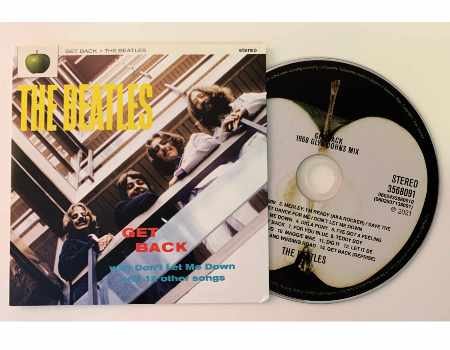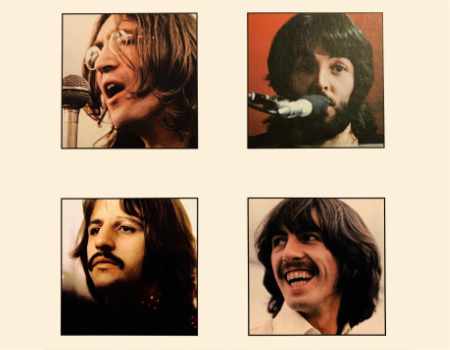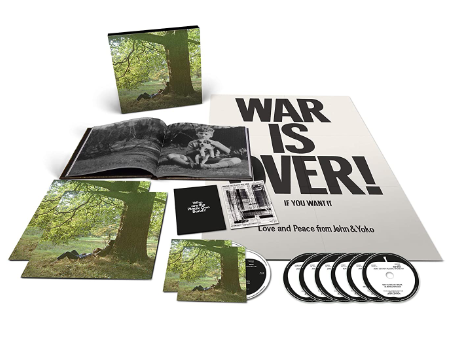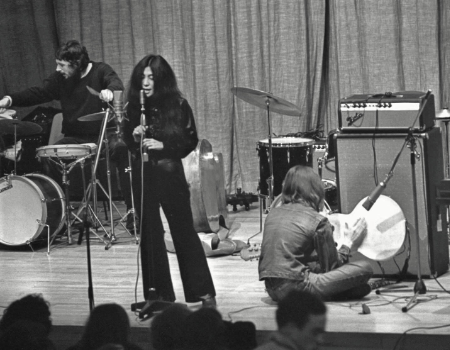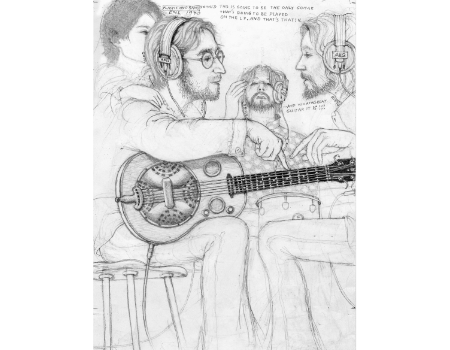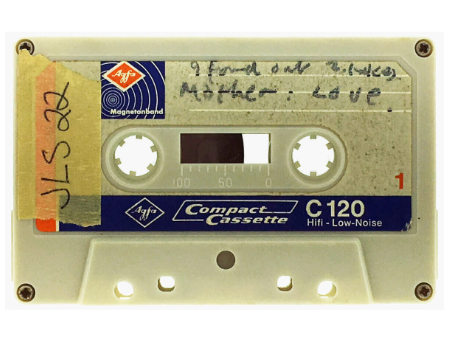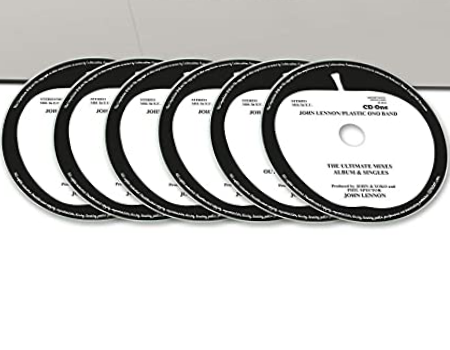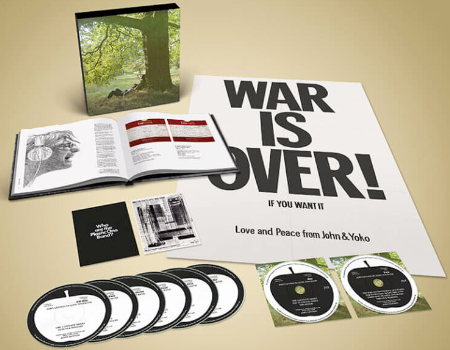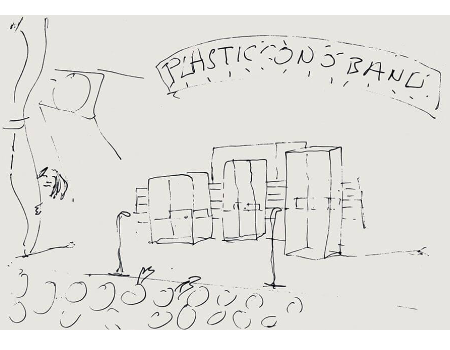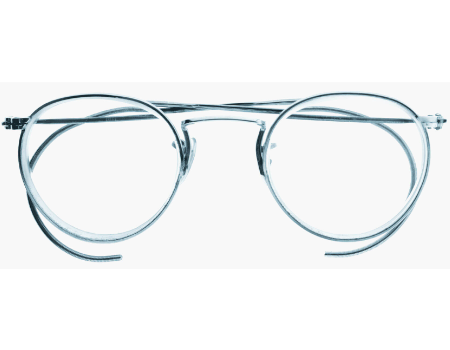Capitalizing on producer/director Peter Jackson’s upcoming six-hour extravaganza, The Beatles: Get Back, Apple Records issues yet another grand Beatles’ vinyl project, based on the Fab Four’s penultimate recording as a band. Following the release of […]
Tag Archives: Phil Spector
In part one of my listening report on The Beatles’ new 50th Anniversary edition of Let It Be we explored the Stereo and Surround Sound mixes in some depth (click here if you missed that). In part two we touched on engineer Glyn John’s wonderful and legendary shelved vision for the original Get Back album which is also included in the set, its first official release (click here for that portion).
Today we’ll explore some of the outtakes and alternates recorded during the Get Back / Let It Be sessions. While there was much impromptu jamming and fun as the group ran through loose versions of favorite rock ’n roll oldies, the band members were periodically presenting new songs to one another for consideration on the new albums.
Perhaps you have to be a deep fan to appreciate this fully, but if you love this music it is often spine tingling to hear these early versions of songs we came to know and love later on Abbey Road as well as individual Beatle solo albums. Its almost akin to watching a painter layering on colors on the canvas, revealing new textures, light and color combinations as the final work begins to take shape.
Thus we get to hear fascinating early run throughs of songs which ended up on solo Beatle albums such as George Harrison’s “All Things Must Pass” (title of his eventual first album in 1970), John Lennon’s “Gimme Some Truth” (which appeared on Imagine in 1971) and Paul McCartney’s “Teddy Boy” (which was completed on his first solo album).
On two dedicated and great sounding stereo CDs included in the six disc boxed set 50th Anniversary edition of Let It Be we also hear early rehearsals and work outs on songs which ended up on Abbey Road. Included are McCartney’s “She Came In Through The Bathroom Window” and “Oh Darling.” Lennon breaks out “Polythene Pam” and George offers up “Something” in an early version where he doesn’t even have the lyrics to the opening line complete (singing the placeholder lyrics “…. attracts me like a pomegranate”). We are even treated to Ringo playing his “Octopus’ Garden” on piano for the band!
The 50th Anniversary edition of Let It Be boxed set includes a bonus “EP” featuring four songs which have their own unique place in the Beatles universe. The stripped back mix of “Across The Universe” is very close to the original 1968 version of the song which appeared on a benefit LP in the UK, featuring lots of Sitar droning and high background choruses from some fan singers who were brought in on the session. There is a different mix of “I Me Mine” recorded by George, Paul and Ringo just after New Years in 1970 (John was away on holiday).
Here you’ll also find a new mix of the original single mix of “Don’t Let Me Down” which appeared as the B-side to the classic “Get Back” single in April 1969 — this has some different overdubs on it than other versions. And finally on this EP you’ll hear a sweet new mix of the original 45 RPM single version of “Let It Be” which again included very different overdubs from what you hear on the LP. For many of us, this was the first version of “Let it Be” that we heard on the radio so this is especially sweet to hear it with such clarity and focus.
This single is great way to end the collection with that radio-ready mix. It was so comforting at the time to hear that on the radio in very heavy rotation. So many of us were grappling with the madness of the moment societally, coupled with the heartbreaking news of The Beatles breaking up. It was a “lotta lotta,” as a friend of mine sometime says. “Let it Be” took that sad song and made it a bit better…
50th Anniversary edition of Let It Be is available in a multitude of formats most every place where you can find music these days. And while it is streaming, to get the most out of this package you really owe it to yourself to buy the boxed set in some form to get all these outtakes and alternates and the beautiful hardcover 100-plus page full color book. This is an elegant and fitting tribute to the Let It Be and Get Back albums and the band.
Now I’m just looking forward to the upcoming Peter Jackson-produced documentary on Let It Be and Get Back (airing on Disney + over Thanksgiving weekend!). Plus, there is the fanboy hope that maybe — just maybe, as I’m purely speculating here, folks — that we’ll get a companion soundtrack album featuring the entire rooftop concert the Beatles performed during the making of the album.
Fingers crossed!
Until then the 50th Anniversary edition of Let It Be is a more than welcome addition to my collection and I know I’ll be listening to it a lot in the weeks and months to come.
If you are reading this review of the new 50th Anniversary edition of Let It Be I assume you know some of the back-story on the making of the Let it Be album and the challenges the band faced in creating the recording as we know it today. If you missed part one of my listening report on the new Stereo and Surround mixes, please click here to catch up on that important portion which explores final producer Phil Spector’s vision for the recordings in 1970. And if you want even more insights on the entire related celebration series — including an upcoming documentary! — please click here to jump to my earlier preview overview.
One of the central elements in the Let It Be legacy (and rock ‘n roll mythology, if you will) revolved around a series of test mixes and and potential album concepts assembled — back in the day before Phil Spector’s work — by acclaimed engineer/producer Glyn Johns. Test mixes were pressed on one-off acetate discs and distributed to the band members for consideration. But, in short, nothing was ever formally decided upon and ultimately Johns’ idea for what the Get Back album (as it was known then) might have been was shelved.
However, before it was nixed and put into the archies, someone outside the Beatle’s internal universe got their hands on the recording — Lennon is quoted in the book in the new boxed set that he thought it was probably his copy — which leaked out. And, before you knew it bootlegs were appearing on the underground market being sold to ravenous hardcore Beatle fans even before the Let It Be album was eventually released (after Abbey Road) in 1970. Over the years various and sundry versions of this bootlegged — really, pirated would be a better word — album have appeared sometimes bearing rather sophisticated production qualities that looked — and sounded — quite legitimate to the average consumer (especially by the CD era).
Well, now that we have the genuine real deal version of the Get Back album included with the new 50th Anniversary edition of Let It Be super deluxe edition boxed set. Now, this infamous and beloved precursor can take its rightful place alongside Phil Spector’s mix in Let It Be history.
Glyn Johns’ Get Back album is important because in it is indeed closer in concept to The Beatles’ original vision for what the album was supposed to be about in the first place: a return to their roots, more stripped down and live sounding. That back to the egg (if you will) idea was taken all the way down to the album’s original design, which mimicked The Beatles’ first album, Please Please Me, featuring an updated photo taken in the exact location as their debut release.
If you are listening to Get Back for the first time, you need to go into this with open ears. There are some very cool things happening on it but it is a much rawer listening experience, intentionally far from the pristine sheen of Abbey Road or even Spector’s Let It Be mix.
Listening to Get Back you feel a bit like (in Glyn Johns’ words) a “fly on the wall,” which was part of his intent. At times you’ll hear songs start and stop in an abrupt manner as if you were in the studio with the group as they rehearsed. You’ll hear snippets of studio chatter and other noises one wouldn’t necessarily come upon in a polished commercial album release. Some of the spoken word bits appear in very different places than where they showed up on Spector’s Let It Be. Most notably, Lennon’s famous line about hoping the band “passed the audition” appears at the end of Get Back‘s opening track “One After 909” instead of at the end of the song “Get Back” at the end of the Spector / Let It Be version.
You will even hear works in progress such as Paul McCartney’s song “Teddy Boy” which eventually was released (in different form) on his first solo album. We get to hear fun impromptu jams and a charming off the cuff romp through The Drifters’ “Save The Last Dance For Me.”
From my perspective Get Back is essential listening for even the casual Beatle fan (thus I dedicated a whole review to my listening report series!).
How important was this album’s original concept to The Beatles themselves? Well, decades later eventually Paul McCartney took it upon himself to try to recreate the vibe they were going for initially, issuing Let It Be… Naked in 2003. Using different takes from the session, that album went a long way to correct some public perception about what the Get Back album might have been like.
I find Glyn Johns’ approach more intriguing and ultimately satisfying as an end-to-end album listen, however. Between the three versions you should be able to get a good sense of the depth and flexibility of the music on these albums.
Many younger Beatle fans may find Glyn Johns’ versions of Get Back appealing because it frankly sounds like an indie rock album. I’ll put it this way: if you like Guided By Voices’ patchwork approach on their legendary albums like Bee Thousand, you might well enjoy the vibe and surprises on Get Back.
Ultimately, we will never know what Get Back might have been had the group finished it the way they’d originally intended back in the day. But Glyn Johns’ Get Back is the next best thing, especially when coupled with the wealth of great sounding studio outtakes which we now have officially at our fingertips (more on that tomorrow).
Get Back sounds fantastic and I could imagine hearing it played on FM radio in the 1970s or the 1990s! Hopefully it will get some airplay in the 00s!
The compact disc version of Get Back sounds wonderful, warm and round and very much like one might expect the raw Let it Be recordings to sound.
And if the CD sounds this good, I suspect that the vinyl edition will sound even better so as soon as I get a copy of that version in hand, I’ll be sure to share an updated listening report with you here on Audiophile Review. I do wish Get Back was included on the Blu-ray Disc in the set, but alas that was not to be. However, the album is streaming in high resolution 96 kHz, 24-bit fidelity on Qobuz Hi Res (click here) and Tidal MQA (click here). Get Back sounds fab there!
Get Back is also a great way to whet one’s palate for remainder of the new boxed set so please tune in tomorrow when we’ll explore some of the outtakes on the new 50th Anniversary edition of Let It Be.
A few weeks ago you might remember that I previewed a new boxed set celebrating the 50th Anniversary of The Beatles’ legendary “last” album that wasn’t really their last, Let It Be. If you missed that feature, please click here so you can catch up on important background for appreciating this current review.
Crafted during a difficult period for the band, the album was actually recorded before 1969’s Abbey Road but not completed and released until 1970. This new 50th Anniversary edition of Let It Be features not only new Stereo and 5.1 Surround Sound remixes of the Phil Spector-produced album but it also includes the much anticipated (and long bootlegged) earlier version of the album by engineer Glyn Johns. Plus, we also get a wealth of session outtakes and a beautiful hardcover full color book that is chockfull of important insights and some incredible photography from the period.
I suspect that the first question some of you may have is: do I need this boxed set?
The answer to that will depend on how deep of a Beatle fan— and how “into” the Get Back sessions (as they are often called) — you are. Deep Beatle fans will want this set. I personally welcome a set like this which curates and focuses our attention on the “best bits” from the sessions.
In this part of my listening report, I’ll explore the new Stereo and Surround Sound mixes of the original album as heard on the high resolution Blu-ray Disc included with the 50th Anniversary edition of Let It Be.
I have to preface this review with an admitted bias: I genuinely like the original Let It Be album a lot! I bought it with my own saved-up money when it first came out; dating myself, I was maybe nine years old!
Yet, like many of you out there in the Beatle universe, I too have mixed feelings about it. It wasn’t until many years later — when I started to hear grumbles from some Beatle fans who disliked Spector’s dense orchestrations — that I learned that Paul McCartney himself didn’t like Spector’s treatment of his classic “The Long And Winding Road.” All this gave me pause to consider whether Spector’s work was off the mark.
On the one hand I can see the nay-sayer’s point of view, especially on “The Long And Winding Road,” where the choirs, harps and strings do jump the shark (if you will) into that sort of schmaltzy easy listening vibe which was popular in some 1950s and early ‘60s mainstream pop productions. On the flip side, that Muzak-esque vibe is not all that far removed from the closing track of The Beatles’ White Album, “Goodnight.”
Listening with fresh ears in preparation for this review — and with additional perspective as a songwriter producer myself — I think that in certain instances Spector’s additions do help elevate and escalate the songs as compared to their stripped down counterparts. They certainly made the songs viable for commercial radio play in 1970.
As cool as it is, I wonder how engineer/producer Glyn John’s stripped down version of the album (which we’ll explore tomorrow) might have fared on AM radio back in the day — to my ear, his album’s sound is ultimately more of an FM oriented vibe. Again, we’ll explore that more tomorrow.
At the end of the day, Spector’s mix is what it is. And at that moment in time it worked as a sort of bittersweet farewell to the band, delivering an end-of-an-era vibe which still can draw a tear from this lifetime Beatle fan. Giles Martin refers to it as a “timeless sound” in the book included with the new boxed set.
So it is with that perspective that I applaud The Beatles and Giles Martin’s team for deciding to try to make the most of the Spector production for posterity.
In fact, Sir Paul McCartney himself — again, he the understandably most upset by Spector’s mix — has gone on record in the book accompanying the 50th Anniversary edition of Let It Be saying “The album we made was given to Phil Spector to put the finishing touches to and even though, I must admit, I was not keen on some of his additions it turned out to be a fine Beatles album in the end.”
So, there we have it. Paulie likes it! Kidding aside, this reminds me of XTC’s Andy Partridge who has acknowledged in retrospect that despite all the challenges they went through creating their masterpiece Skylarking, Todd Rundgren’s production helped shape the album into the beloved recording it is today.
So, rather than strip away the production aesthetics, Giles Martin and his team have preserved Spector’s work and tried to make it sound as good as possible in the context of The Beatles’ original music. To that, I think Martin has found a nice equilibrium on the 50th Anniversary edition of Let It Be. More on that in a moment.…
As with Martin’s work on Sergeant Pepper, The White Album and Abbey Road he has made the vocals clearer and the instruments more defined in this new remix.
In general, the acoustic guitars are lush, woody and resonant sounding throughout in these new Stereo mixes, especially noticeable on tracks like “Across The Universe,” “Two Of Us” and “For You Blue.” Ringo’s drums sound beautiful and natural throughout. They are much more distinct now so you can really feel his incredible fills on the rocking bridge section of “I Me Mine.”
“I’ve Got A Feeling” brings up Lennon’s backing vocals more so the “oh yeah’s” he and McCartney sing feel a bit more raucous and exciting together. McCartney’s bass on “One After 909” felt a wee bit hot in the mix on my Stereos but that is a minor point and ultimately it does propel the song on better in an appropriately bouncy manner.
Back to the Spector portions of the mix, his arrangements seem just a tad lower on “Across The Universe.” There is now incredible clarity on “Let It Be” allowing you to hear each of The Beatles’ instruments vividly while the strings and choirs are just a smidge lower in the mix — it is not as much of an assault (if you will) as it is on the original mix, putting the band at the song’s center.
As I mentioned earlier, arguably the biggest offender in the original mix — which you will read in the book in boxed set just how much it offended Paul McCartney — happened on “The Long & Winding Road.” On Giles Martin’s new mix, Paul and his piano are more up front (so it feels more like Beatles with strings vs. strings with Beatles, if you will). The bass is more audible and the choirs are pulled back a bit at times as are the harps. Notably, now you can hear Paul’s closing piano flourishes which are no longer buried by the strings — everything is blended together quite splendidly. You can also more clearly hear the subtle emotions in Paul’s voice which at times were overshadowed by the strings (for example, listen how he holds the note singing “let me know the way…” around the 1:20 mark)
In general, I was impressed how warm the 96 kHz, 24-bit Blu-ray treats the music. I’ll put it this way: it feels like Let It Be should feel, not an overly bright effort to make it sound modern or whatever. It is clear and crisp but it also sounds remarkably rich.
THE SURROUND SOUND MIX
As nice as the Stereo mix is, I think I like the Surround Sound mix just that much more because it opens up the music. It reveals even more of the original live band feel yet retains that lush and distinctive studio vibe.
In general, the orchestral strings lean toward the rear channels leaving you to more fully hear the core of the band in the front channels. It is a logical approach that works very well, creating an immersive effect and a new listening experience that is not gimmicky. For those of you still on the fence, this new perspective might help re-define your appreciation of this version of the album.
Keeping the band to the front channels mostly makes for a gently immersive mix with some tasteful touches, periodically using the surrounds for acoustic guitars and lead lines.
“I Dig a Pony” rocks madly in 5.1 surround (be sure to listen for Ringo’s final cymbal crash).
“Across The Universe” is even more haunting in surround sound, if that is possible. The choirs and harps are somewhat lower in the mix but you can at times almost feel them around you. The only casualty I noticed is that the Sitar sounds much more blended into the mix (this is true on the new Stereo version as well, by the way). As much as I like that detail popping out on the old mix, this new incarnation sounds tighter and more focused, yet no less dreamy. And again, it keeps the listener’s attention on Lennon’s vocals.
Ringo’s kick drum and tom toms on “I Me Mine” are huge and his awesome rolling fills sound massive here. Again, the orchestral parts being a bit lower in the mix feels more natural, less invasive and beneficial to the song. I can hear more overdriven guitar amplifier tone coming through on the signature boogie in the rocking section.
“I’ve Got A Feeling” puts the core band and driving rhythm guitars up front and center with Billy Preston’s keyboards emanating from the rear with the lead guitar. “The Long And Winding Road” finds the strings and choirs mostly in the back and I even noticed a nice Fender Rhodes-sounding electric piano part there which was not super audible on the original mix.
Billy’s honky tonk tack piano percolates towards the rear, coming up more in the mix for the solo on “For You Blue,” while John’s slide parts fill up the room.
And so it goes on the 5.1 mix for the 50th Anniversary edition of Let It Be — there is much surround sound richness to enjoy here!
Tune in tomorrow when we’ll explore the very important first official release of Glyn Johns’ 1969 vision for what the Let It Be album might have been in its original guise as Get Back.

As a youth in the early 1970s I was entranced by George Harrison’s third solo LP, All Things Must Pass. John Lennon’s then new Plastic Ono Band was equally high on my list, even if […]
In part one and part two of my listening report on the news super Deluxe Edition of George Harrison’s 1970 epic first solo album, All Things Must Pass, we explored the brand new stereo and surround sound mixes respectively. If you missed those portions of the review please click here for the stereo and here for the surround sound to catch up.
Today we’re going to explore the wealth of demos and outtakes in the boxed set.
One of the big-smile-inducing — and even enlightening — moments for me while listening to this set occurred when I got to a particular outtake on Disc Five of the new George Harrison All Things Must Pass boxed set. There, a two minute take of George and his band doing The Beatles’ smash hit ”Get Back” is a wonder. It is not a total throw-away lark. He’s got all the lyrics down on it and they are working through the tune, replete with an acoustic guitar solo and horn section punching up the chorus hooks. It is so great to hear George embracing a Beatle tune in a new way.
There are other revelatory moments on this wonderful boxed set which you’ll get to explore across two full CDs of demos cut on the first two days of recording sessions for All Things Must Pass. These are a combination of solo George Harrison acoustic performances as well as some backed by a core power trio (likely Ringo Starr on drums and Klaus Voormann on bass guitar).
Much like the demos on the recent John Lennon Imagine and Plastic Ono Band sessions sets, these are a wonder because you’ll hear — in many cases — just how fully formed Harrison’s ideas for the songs were.
So on some tracks you’ll hear George singing arrangement parts that ended up as orchestral or pedal steel guitar counter melodies on the final recording. It is really quite fascinating and wonderful to experience. In effect, you’re hearing the audio equivalent of a master painter’s pencil sketch before he even gets to canvas
One of the biggest surprises for me as a lifetime Beatle-and-George-Harrison fan was hearing a blues-y back porch, dobro slide guitar version of a song which didn’t appear on an album until Harrison’s 1976 release titled 33 & 1/3 — “Woman Don’t You Cry For Me.” It’s a great version of the song and a nifty twist showing how he’d originally envisioned the arrangement which ultimately ended up a sort of slightly funky rocker.
Amidst the demos are quite a number of songs which did not make it onto the final album. In some instances it’s quite obvious as to why they were left off given the sheer strength of the other songs they were up against. In some instances I suspect that thematically and perhaps musically some of the songs didn’t quite fit in.
In the original triple-album boxed set there was a disc titled Apple Jam which pretty much delivers exactly what it implies: loose free wheeling jamming between the session musicians. These jams include work which is considered the first recordings of the legendary band that became known as Derek and the Dominoes.
In the All Things Must Pass box set the jams are extended with fun alternates, out-takes and some vintage covers. Don’t be shocked by the hysterical partial take of “Isn’t It A Pity.” The 1929 barbershop gem “Wedding Bells (Are Breaking Up That Old Gang Of Mine)” at first seemed surprising but the wiki reminded me that Gene Vincent included a cover of it on his 1956 debut. The spiritual “Down To The River (Rocking Chair Jam)” is another surprise joy. And the “Almost 12 Bar Honky Tonk” is a better jam than much of what ended up on the original Apple Jam disc!
And so it goes on this richly rewarding collection.
All Things Must Pass is rounded out by a beautiful booklet curated by Harrison’s wife Olivia. It also features many behind-the-scenes photos of the sessions, reminiscences as well as a track by track overview of what is on the collection.
From a design standpoint, I also like the small form of this box that which is a bit more compact than even the John Lennon sets but it feels no less robust. In fact I think it’s quite beautiful the way it’s laid out, especially with its purple-bordered, orange-trimmed interior and red ribbon adding an air of elegance to the package. I also have to comment that it’s really cool how they used the design of the actual Apple Records demo labels for the demo disc. It is this sort of attention to detail that Beatle fans appreciate.
In tomorrow’s closing episode I’ll explore the eight LP vinyl version of All Things Must Pass, a super duper deluxe boxed set with the original three LP set and a five disc version of the demos and bonus material. Be sure to tune in…

Yesterday we explored the fine new 50th Anniversary Stereo remix of George Harrison’s classic 1970 release All Things Must Pass. If you missed that review, please click here to catch up.
Today I will attempt to explore and describe the joys (and periodic hurdles) of enjoying the new surround sound mix of All Things Must Pass, crafted by Paul Hicks of Abbey Road Studios and Dhani Harrison.
While I don’t know exact details of how the mixes were made — and the original production realities which may have impacted critical remix decisions made along the way — in general I found the 5.1 surround sound version of All Things Must Pass quite enjoyable. As I don’t yet own a Dolby Atmos compatible system, here I have been listening to the DTS HD Master Audio version (192 kHz, 24-bit). For what its worth, when I engaged the Dolby Atmos version on my Oppo BDP 203 universal player, it defaulted to Dolby TrueHD at 48 kHz resolution; it sounded markedly thinner so I didn’t spend any time listening to it, realizing it was likely a compromised presentation of the music.
That said, the 5.1 DTS HD Master Audio mix has its breathtaking moments with some curious twists and turns. At times the mix feels very discrete, other times less so. I suspect this may have something to do with the sound design by original co-producer Phil Spector.
In many ways, his mix of All Things Must Pass was an extension of his “Wall Of Sound” technique which caused a sea change in music production and catapulted many artists like The Ronnettes and The Righteous Brothers to the top of the charts in the early 1960s. Thus, spreading out — and even removing — elements of his production elements may have been a challenge when making a surround sound remix given how tightly those parts may have been integrated for the original Stereo mix.
Accordingly, most of the action for the 50th Anniversary surround sound remix of All Things Must Pass takes place in the front channels with lead vocals generally relegated to the center speaker. Periodically, you’ll hear harmonies in back channels as well as support instrumentation, from guitars and banjos to (what sound like) synthesizers. Other times, the mix takes a more soundscape-like approach and is less discrete, filling the room with studio ambiance (and a fair amount of reverb or echo/delay).
Like in the Stereo mix, the drums and bass have received a significant facelift and are much more prominent and distinct. The Tom Toms especially sound fantastic percolating across the front channels (typically).

I did notice that my usual “sweet spot” for listening was not necessarily always the best place to be when listening to this mix of All Things Must Pass. That is not a bad thing, mind you as it prompted me to stand up and walk around the room a bit more. At times I found standing a foot or two back further (ie. behind my couch) was preferable. If I had to guess, perhaps this was some sort of trickle down effect from the producer’s work on the Dolby Atmos mix (which adds height channels to the surround). But… I’m just speculating here folks, so take this with a grain of salt, for what it is worth.
Here are some track by track observations you may find tantalizing:
“If Not For You” (co-written with Bob Dylan) works especially well in surround sound, placing George’s big strummy acoustic and electric slide guitars around you. The country-western flavored “Behind Locked Doors” is particularly gorgeous with great detailing of vocal harmonies and some guitars in the rear channels. Likewise, “What Is Life” places signature riffs and even some (what I think may be a) Banjo in the back speakers.
“Let It Down” rocks like nobody’s business and features some rich sax breaks and slide guitar parts popping up in the back channels. I’ve said this before about the Stereo mix but it bears repeating here as well: the drums are positively huuuuuge! here. The room-filling acoustic guitars on “Apple Scruffs” sound fantastic and the layered acoustic intro to “Run Of The Mill” is quite spectacular.
As on the new Stereo mix, “The Ballad of Sir Frankie Crisp” takes on a higher profile than previous editions I’ve heard as that low voice now haunting the track is positively wonderfully creepy!
There are subtle details revealed in this new mix. For example, on the title track All Things Must Pass I never noticed that (I assume it is) Ringo is playing this tight doubled-up kick drum beat which helps to propel the song along with the bass lines.
I admit that maybe I was imagining it, but it seemed like on “I Dig Love” there were subtle ascending and descending note sequences call-and-response criss-crossing one another diagonally across the room (ie left front and right rear and then switching to front right and left rear). As with much of this mix, even though it was much clearer with a lot of the Spector reverb removed All Things Must Pass remains a lush recording at its root so I suspect there will always be some inherent softness to the final sound.
I will continue to listen to to the 5.1 mix and may update this article with new observations in the weeks ahead. But I think this should give you a good preview of what to expect from the 50th Anniversary surround sound remix of All Things Must Pass.
Tune in next week when I’ll explore the wealth of Demos on the set and the eight-LP vinyl-only version of this fine boxed set series.
If you’re an analog, aka vinyl lover, I’ll cut to the big magilla: John Lennon’s remastered solo debut LP, Plastic Ono Band, humiliates the original 1970 US pressing. The new pressing, which I assume was […]
My deep dive into the 50th Anniversary super deluxe boxed set celebrating John Lennon’s landmark solo album Plastic Ono Band concludes today exploring some of the outtakes, alternates, and other fascinating bonuses on this rich collection. In case you missed Part II on the new Surround Sound mix, please click here. And for Part I on the Stereo remix, click here.
Plastic Ono Band presents multiple visions for the album. Each CD — also included on the Blu-ray Disc — gives you 14 tracks, corresponding album tracks plus period singles in various states of being. New “ultimate” mixes of studio out-takes are offered as well as new mixes/remasters of demos and new mixes of the “elements.”
You get “raw” studio mixes including the outtakes (different outtakes!). And then the “evolution” mixes are mini audio documentaries of each track’s birthing process. There are the jam sessions! And, on the Blu-ray you get all the live sessions the band did with Yoko Ono (which became the core for what became her first solo album, also titled Plastic Ono Band).
The CDs generally sound excellent but if you want to hear the fullest versions, listen on the Blu-ray Discs which are presented at 192 kHz and 24 bit resolution in Stereo. The vinyl LP version of Plastic Ono Band also sounds excellent but only offers you one series of the outtakes (more on that in a bit).
There is so much here I really can’t get to it all in this already-too-long review series, so I’ll try to be as complete as I can (without going to a fourth review!)
OUTTAKES ’n ALTERNATES
All of these tracks sound amazing and offer incredible fly-on-the-wall insights into the process John Lennon went through creating Plastic Ono Band. The remarkable thing is that for all these years many of us thought that Plastic Ono Band was this stripped down raw affair which couldn’t possibly have been as intense a production as, say, The Beatles’ Abbey Road or Sgt. Pepper.
But when you look at the number of takes Lennon did of some of these songs you realize he went through quite a process to get to that final sound. He went through nearly 100 takes of “Mother” to get to the final version that opens the album!
It takes a lot of work and skill to create something seemingly this simple.
My favorite outtakes thus far include the heavily overdubbed 23rd take of “Isolation” with multiple vocal takes all at once. Take 6 of “Love” is a simple acoustic guitar demo, like he is playing it on a back porch. Take 2 of “Look At Me” is innocent and folksy. Take 27 of “God” is amazing with its somewhat different introduction and vocal style. Take 1 of “Cold Turkey” mesmerizes.
On the Two LP vinyl version of Plastic Ono Band you get a second disc featuring the “Raw” studio mix outtakes as found on the Blu-ray disc (different than the CD). The LP sounds great if you like that format and is a nice complement to the super high resolution Blu-ray version.
THE DEMOS
On Disc 6 of the CDs (again, also on the Blu-ray) you get a full set of John’s earliest cassette demos. These “are what they are” sound quality wise, but are an essential part of the journey. Some highlights include the early take of “Mother” played by John on guitar on a heavily vibrato-laden electric guitar. The piano and vocal demo of “Isolation” is a tear jerker as is the similarly produced “Remember.”
“Look At Me” sounds like it was recorded over a telephone line and is wonderful as the essence of the song is all there even at this early stage. “God” is probably the most radical departure, strummed early on as a somewhat fast folk song on a guitar.
Essential listening, no doubt.
ELEMENTS MIXES
Stripping each song down to its most basic essence, these are a fascinating study in the power of isolating performance details
“Mother” is especially haunting, stunning and beautiful presenting Lennon’s vocal take in its entirety without any backing. It is especially harrowing to feel the emotion in his voice toward the end, alone on the high wire without a net.
“Hold On” is beautiful just as a solo electric guitar and vocal mix. “I Found Out” is an alternate vision of the song with funky congas changing up the vibe. Lennon breaks into some rock ’n roll oldies during the ensuing jam session — this would have been an amazing song for Lennon to play live!
The “Jews Harp” boinging in the background behind “Remember” is a fascinating timekeeper, establishing a bouncing beat reminiscent of McCartney’s bridge section on The Beatles’ “A Day In The Life.” The extra resolution on the Blu-ray Disc version is important here as the harp is more audible their than on the CD — at roughly four times the resolution of a CD, this is an easy to comprehend example of what the 192 kHz, 24 bit version delivers.
The elements take of “God” places Lennon’s voice in an enormous echo chamber! His vocal approach is completely different, almost like a quiet church prayer vs. the soul-torching take that ended up on the final take.
“Cold Turkey” without vocals is tremendous. Listen for the ring of Ringo’s snare drum and bits of sweet feedback chiming from the guitars. Ringo’s kick drum and Klaus’ bass are way up in the mix, making it very powerful on the low end. This sounds especially great on the Blu-ray Disc.
THE RAW MIXES
These versions may actually rock a bit more than the regular album given they are unencumbered by any real production beyond how the microphones were set up. Each song is mixed raw without effects, tape delays or reverbs. In someways, these raw mixes are more pure John Lennon without the relative vagueness of Phil Spector’s aesthetics.
Lennon could have put out Plastic Ono Band like this back in the day and it would have perhaps shocked even more. When you hear his throat-tearing vocals on “Mother” you realize that most of the sound of Plastic Ono Band was nailed down before Spector added his final touches. “Remember” is remarkable as it rocks madly stripped naked to its core.
THE JAMS
Disc 6 features fun outtake jams from the session with John and the band letting loose working through some rock ’n roll oldies. Included are “Johnny B. Goode” and “Ain’t That A Shame.” They break out a track the early pre-fame Beatles used to do live called “Glad All Over” (there are BBC recordings of them doing this, with George singing). And there are neat oddities like “Lost John” and The Weavers’ traditional folk classic “Goodnight Irene.” We even get treated to an early acoustic guitar version of a song that ended up on the Imagine album, “I Don’t Want To Be A Soldier,” which sounds more like the Grateful Dead than an ex-Beatle!
THE EVOLUTION MIXES
As in the prior Imagine boxed set, here in this new Plastic Ono Band collection we get a series of fascinating audio-only quasi documentaries. Here the producers take you through the formation of each track leading up to the final take. Its fun hearing John working out “Hold On,” even getting a little playful along the way. “Isolation” with the organ at the start of the song is a fascinating church-like variant.
It is also wonderful to hear John interacting with Yoko from the mixing booth on these recordings. Along the way she offers great input to what Lennon was trying to accomplish and clearly has solid working knowledge of the studio process even that early on in their relationship.
Speaking of Yoko, there is a fascinating bonus Blu-ray Disc in the set which I am still exploring featuring her complete live sessions with the band. These tracks became the basis for her first solo album, also titled Plastic Ono Band and featuring a similar cover design to Lennon’s release here. Once I get deeper into this I plan to write a follow on review as I also recently picked up one of the nice vinyl reissues of her album on vinyl issued on the Secretly Canadian label. More on that soon…
THE BOOK
I’d be remiss if I didn’t mention the 100-plus page hardcover book included in the set. This is essential reading as it goes into remarkable micro-detail on all the facets of the set as well as insights into what was going on in John & Yoko’s universe at the time.
Included is fascinating information on the genesis of the Plastic Ono Band name as a group, what it meant and how it was brought out to the world at the time — finally, we get some understanding of the cover image on the “Give Peace A Chance” single!
The pictures alone are a fantastic treat, everything from original tape box shots to period pix of John and the band members. Klaus Voormann even contributed drawings he’d made from the sessions (Beatle fans know he drew the iconic cover for The Beatles’ Revolver album).
You also get a wonderful “War Is Over (If You Want It) poster and postcards featuring art from Lennon’s early singles from this period.
So… wow! Plastic Ono Band is 50 years old and sounds more vital than ever. And now we have this fantastic periscope into Lennon’s artistic creative process which will no doubt be important to music scholars and Beatle-philes for ages to come.

Los Angeles, CA (January 20, 2021)—Producer and convicted murderer Phil Spector died in a prison hospital January 16, 2021. In his music-making prime during the early to mid-1960s, Spector created hit after hit with a rotating series of singers and session musicians, developing the Wall of Sound production method that became his trademark. While his obsessive nature aided his quest to turn simple pop songs into aural epics that exploded out of the mono transistor radios of the era, that same quality also led to severe mental illness, wrathful control issues and erratic, violent behavior that that came to a head with his 2003 murder of actress Lana Clarkson. Sentenced in 2009 to 19 years-to-life in prison, Spector contracted COVID-19 in December, 2020 and died due to complications from the virus. He was 81.
Phil Spector was born in the Bronx borough of New York City the day after Christmas in 1939; his family moved to Los Angeles when he was 14, following the suicide of his father. Forming a group, The Teddy Bears, with high school friends, Spector had his first success penning and co-performing the group’s sole hit, “To Know Him is to Love Him,” in 1958. After they broke up the following year, Spector headed back to New York City, where he became a musical jack-of-all-trades, co-writing Ben E. King’s hit, “Spanish Harlem,” and playing guitar on The Drifters’ “On Broadway.” Returning to L.A., Spector moved into record production and soon began cranking out a seemingly endless stream of hits with acts like The Crystals (“He’s A Rebel”), Darlene Love, The Ronettes (“Be My Baby”), The Righteous Brothers (“You’ve Lost That Lovin’ Feelin’”), Ike & Tina Turner (“River Deep – Mountain High”) and more.
During this era, Spector developed his trademark “Wall of Sound” production method, often working at Gold Star Studios in Hollywood with engineer Larry Levine, arranger Jack Nitzsche and a loose-knit group of first-call session musicians nicknamed The Wrecking Crew. The dense, bombastic sound was based around a near orchestral approach—rather than use the typically sparse instrumentation of the day, a Phil Spector production would have dozens of musicians crammed into one room, with multiple instruments playing the same parts in unison to create larger, thicker tones, whether that was the same instrument—say, three guitars—or different, though related ones, such as a piano, organ and harpsichord. The thick, sometimes gummy sound was further expanded through use of echo, reverb and distortion; this, along with the fact that they were recorded live in the studio rather than multitracked piecemeal like they would be today, gave the performances an immediacy and often overpowering drive that set them apart from anything else on the charts at that time.
Spector went into semi-retirement in 1966, and married Veronica Bennett, better known as Ronnie Spector of The Ronettes in 1968, adopting a son and later surprising her by adopting twins as a Christmas present. It was, by all accounts, a cruel, abusive marriage that found Bennett and the children kept captive in Spector’s mansion, though Bennett ultimately made a late-night escape from their mansion—and marriage—in 1972. In their 1974 divorce settlement, she gave up all claim to future royalties on the Ronettes’ work and likewise gave up custody of their children—a decision she said was made because Spector threatened to have her assassinated. In the decades since, two of the children have alleged they endured sexual abuse due to Spector in the years after Bennett left.
UK Producer Steve Brown, Dead at 65
Pro Audio In Memoriam 2020
By this time, Spector had revived his production career, as he was hired in 1970 to assemble rough takes recorded by the Beatles into the band’s final album, 1970’s Let It Be. While it was a massive hit, Paul McCartney took issue with Spector’s heavy-handed embellishments, eventually going so far as to have the album remixed without them and released as 2003’s Let It Be…Naked. Nonetheless, Spector made inroads with the other Beatles as a result of the collection and went on to record multi-platinum albums for John Lennon (Imagine; Some Time in New York City) and George Harrison (All Things Must Pass; The Concert for Bangladesh). With Spector’s increasing unpredictability, however, both artists eventually stopped working with him. Lennon initially hired the producer for what would become 1975’s Rock ‘n’ Roll, but Spector’s heavy alcohol abuse and wild behavior like showing up to record in surgical scrubs, firing a gun into the studio ceiling, spilling whiskey into A&M Studio’s console, and ultimately kidnapping the session tapes for months at a time, led the project to be shelved for a number of years.
Spector closed out the 1970s recording poorly received albums with the Ramones and Leonard Cohen, and remained largely inactive throughout the next 20 years, sporadically working with on tracks with Yoko Ono, Starsailor and a failed collaboration with Celine Dion (Dion allegedly walked, fed up with Spector’s dithering). Spector spent much of those years in reclusion, fading from public memory, but that ended abruptly on February 3, 2003, when he shot actress Lana Clarkson in the mouth at his mansion. Barely acquaintances, Spector had invited her to his home after they met at L.A.’s House of Blues, and later claimed the death was an “accidental suicide.” Spector’s driver called 911 and quoted him in the call as saying “I think I’ve killed somebody.” After a 2007 trial ended in a hung jury, a second trial resulted in Spector’s March, 2009 conviction.
While Spector’s musical ingenuity is still admired in many quarters, his volatile actions throughout his career have long since overshadowed whatever accomplishments he achieved. He will not be missed.
- 1
- 2









